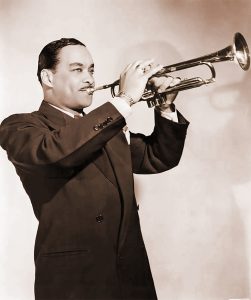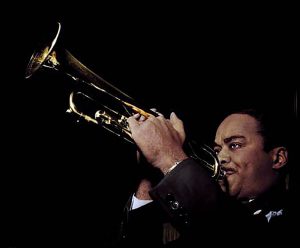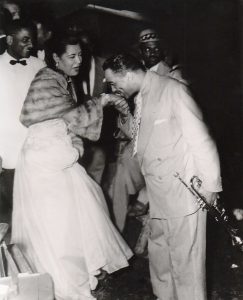Swing Era Trumpeter Buck Clayton
Swing era trumpet player Buck Clayton (1911-1991) is best known for his role in the early success of Count Basie and his Orchestra and his sensitive accompaniment for Billie Holiday’s records. Clayton was the son of a tuba-playing minister, and yet because he had some Native-American blood his mother called him “Buck.” Contemporaries recalled his notable good looks, grand sartorial style, and striking blue-green eyes that won him the nickname “Cat Eyes.”
Compared to other trumpet stars of the 1930s, Buck’s sound was more streamlined, smoother and intimate. His personal style featured a flowing, melodic approach to improvisation, a refined tone featuring subtle use of mutes, a great feel for the blues and fine technique. Widely respected among musicians, Clayton was not a bravura soloist in the Louis Armstrong manner, though he reportedly showed greater passion in live performance.
Clayton’s burnished, understated trumpet tone and tasteful use of cup-mute were distinctive. His restrained style and melodic improvising made him a popular soloist through the Swing era, and a central figure of Mainstream Jazz during the 1940s, ‘50s and ‘60s. His sly, muted trumpet style was an essential element of early innovative Basie hits like “One O’Clock Jump” and “Jumpin’ at the Woodside.”
BUCK CLAYTON WITH BASIE_Jumpin’ at the Woodside.mp3
Early Years Out West, 1933-34
Buck’s colorful stay in Los Angeles is often overlooked, perhaps because there weren’t any recordings. Barely out of high school Clayton was trying to break into the music business while he worked odd jobs — in a barbershop, garage, pool hall.
Central Avenue in L.A. was a jumping jazz district. Clayton became acquainted with notable musicians — bassist Milt Hinton, bandleaders Paul Howard, Charlie Barnet and Lionel Hampton. When Duke Ellington and his Orchestra came to Hollywood for the filming of “Murder at the Vanities” he met Duke and most of the band. It was at this time that Buck met his inspiration, Louis Armstrong. He wrote that in their first encounter, Louie showed him how to make a gliss (glissando: a smeared or bent note). And introduced him to marijuana.
Clayton became familiar with a set of noted Hollywood entertainers and flamboyant local celebrities. He knew black character actor Stepin Fetchit who travelled around town in his caravan of five Cadillacs, and a prominent boxer named Gorilla Jones. He used to stroll down Central Avenue with his lion cub on a leash. Buck worked briefly as an extra on a few films, encountering actresses Loretta Young and Ginger Rogers.
Duke Ellington even threw Clayton a big wedding party. And because Duke’s band played, stars like Mae West and gangster-film actor George Raft attended. Weeks later, Clayton was on his way to China. His band, “The Gentlemen of Harlem,” accompanied piano player Teddy Weatherford for a lengthy residency at the top nightclub in Shanghai, the Canidrome, 1934-35.
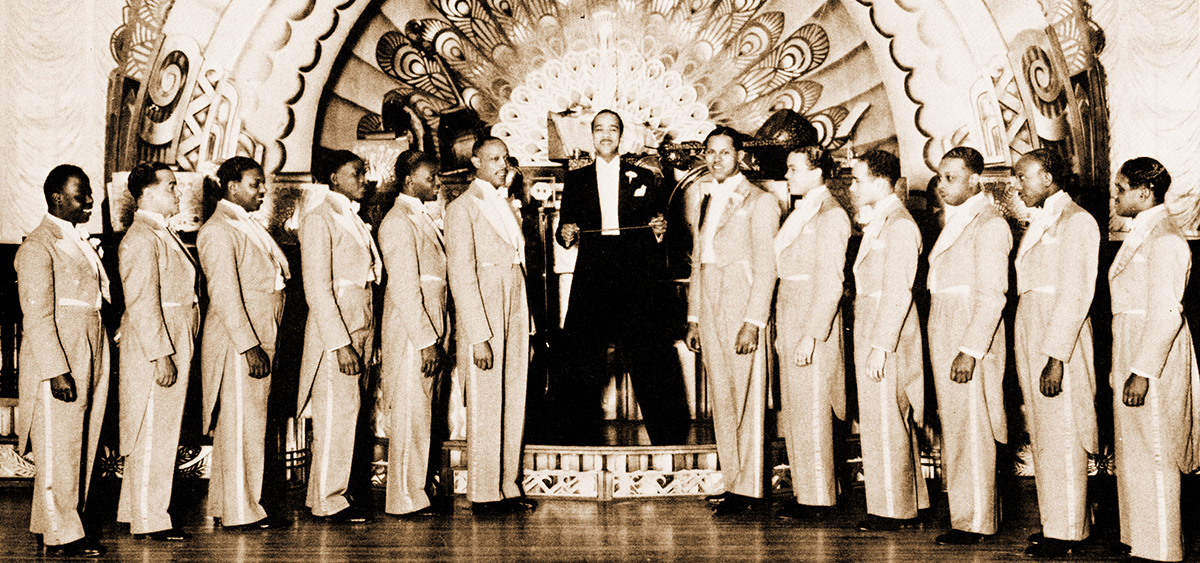
Buck Clayton’s Fourteen Gentlemen of Jazz performed in Shanghai, China in 1934-35. (From Driggs, Black Beauty, White Heat, 1995.)
Joining Count Basie, 1936
HIRED BY BASIE A KC7 Dickie’s Dream & Good Morning Blues.mp3
HIRED BY BASIE B KC7 Easy Does It, After Theater Jump.mp3
Though Clayton was born and raised in Kansas that’s not how he became part of the K.C. music scene. In 1936, he just happened to be in town when Basie needed a trumpeter and was hired practically on the spot. The Basie Orchestra’s sound was like no other. They could blow other bands off the bandstand or create dark and mysterious moods with innovative harmonics.
Clayton was a perfect match for the Basie crew. He wrote, “they never let up. They would swing you into bad health . . . I had never heard such swingin’ music in my life . . . there were only nine of them, but that nine could out-swing anything that I’d ever heard.”
Shocked to be offered only $14 dollars a week initially, he took the job anyway because he loved their music so much. The timing proved fortuitous, they were just about to move east and hit it big. Clayton became a valued component of the Basie inner circle, integral to the early hits and signature tunes, unofficially becoming their music director, contributing arrangements and original tunes.
His vital role extended to the landmark small band sessions of Basie’s Kansas City Five, Six and Seven. The orchestra’s most distinctive soloists, tenor saxist Lester Young, Clayton and trombonist Dickie Wells were often featured in these 1938-39 Basie combos. They were part of a wider trend in Swing. Small groups were transforming jazz and selling very well – The Benny Goodman Trio, Quartet and Sextet (the latter often drew from Basie personnel), the John Kirby Sextet, and Duke Ellington spin off groups.
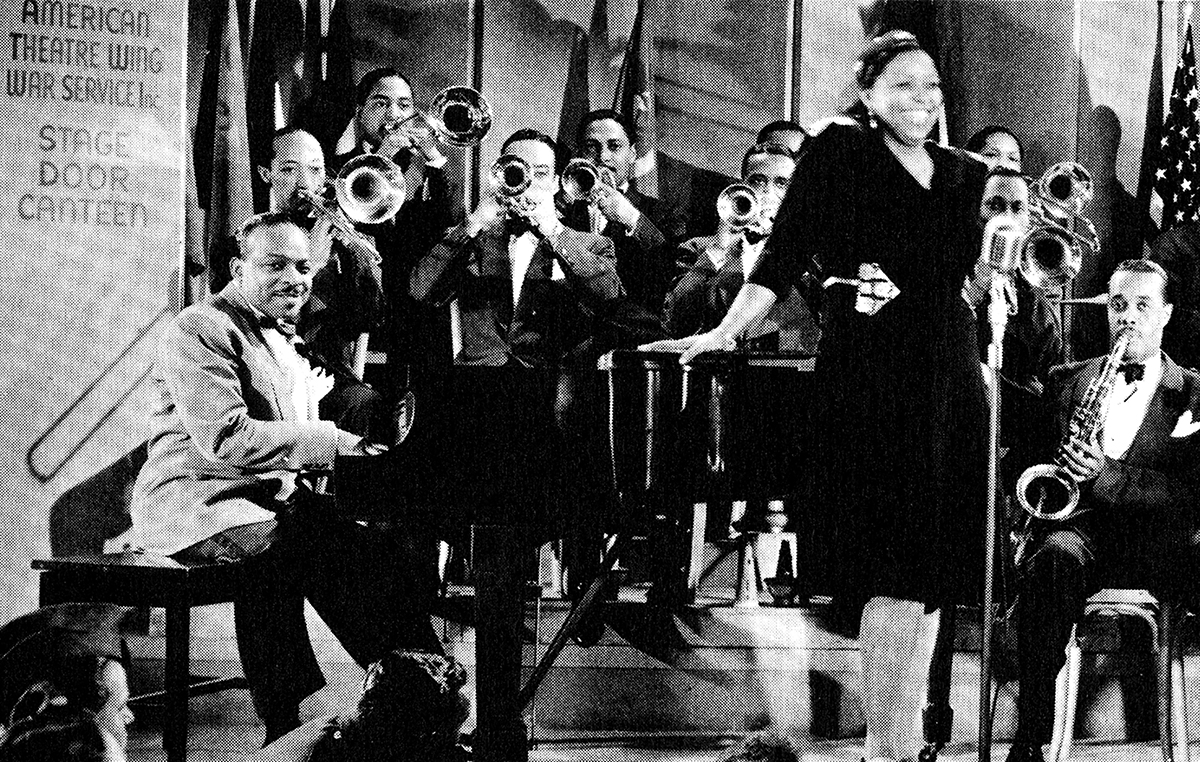
Count Basie Orchestra with Ethel Waters in the 1943 film “Stage Door Canteen.” Clayton is sitting fourth from the left amidst the eight-piece Basie brass. (From Driggs, Black Beauty, White Heat, 1995.)
BUCK AND BILLIE HOLIDAY DOCUMEDLY.mp3
With Billie Holiday, 1937-39
Billie Holiday had a brief stint singing for the Basie orchestra. She and Buck became very close.
Clayton made thirty or so titles with Billie between 1937-39. Like Clayton, her finest studio accompanists were often on loan from Basie: Lester Young, guitarist Freddie Green and drummer Jo Jones. Billie, Lester and Buck revealed new frontiers for intimate interaction between singer and jazz horn.
In his autobiographical memoir, Buck Clayton’s Jazz World (Oxford University Press, 1986) he recalled Billie:
“Billie had joined the Basie band. She was great to work with as she was game to do anything that we would do. She would shoot dice with us, joke with us and, in general, do everything that we would do. We all liked Billie. Sometimes on the bus at night, when everybody else would be sleeping, Billie and I would talk.
We made several more dates with Billie after that, in fact whenever Basie would be in town we were sure to be called to play with the Lady. They turned out to be very successful, especially down South where the people really dug the blues.
Such pleasure I had backing up Billie’s songs to her vocals. When she would record I would watch her mouth and when I saw she was going to take a breath or something I knew it was time for me to play between her expressions. It’s what we call ‘filling up the windows’.”
Life After Basie, 1940s-50s
During World War II, Clayton was briefly in the US Army. Fortunately, he was stationed in New Jersey and could continue jamming and recording in New York City. He played music under the leadership of Sy Oliver and Mercer Ellington (Duke’s son), winning an Esquire Gold Award for “Best Musician in the Armed Forces.”
His career flourished through the 1940s and ‘50s, working or recording with tenor saxophonist Coleman Hawkins, singer Jimmy Rushing, tenor saxist Don Byas, Mezz Mezzrow, Earl Hines, Sidney Bechet, Norman Granz’ Jazz at the Philharmonic, and he appeared in the film “The Benny Goodman Story.” Aside from his fame with Basie and backing Billie, it’s little appreciated that he had an independent career as a recording star, soloist and arranger. Clayton wrote and arranged for Tommy Dorsey, Benny Goodman and Duke Ellington.
He was a valued all-star soloist for studio jam sessions and on the international jazz festival circuit. Popular worldwide, Clayton toured Australia, Japan and Europe several times with extended stays in France. He learned French easily, recording with a sextet under his own name in Paris, 1949.
Clayton was one of the few trumpeters to mature before 1940 who successfully adapted to the changes in Jazz after WW II. Though he never fully made the transition to Bebop or Modern, Clayton took an independent stance that some called Mainstream Jazz (or Bop-influenced Swing). He waxed notably progressive recordings with Ike Quebec and composer/pianist, Leonard Feather in the mid-1940s.
6) MAINSTREAM JAZZ_ Scram, Cup-Mute Clayton & recap.mp3
- (Page 1 of 2)
- Next page →


